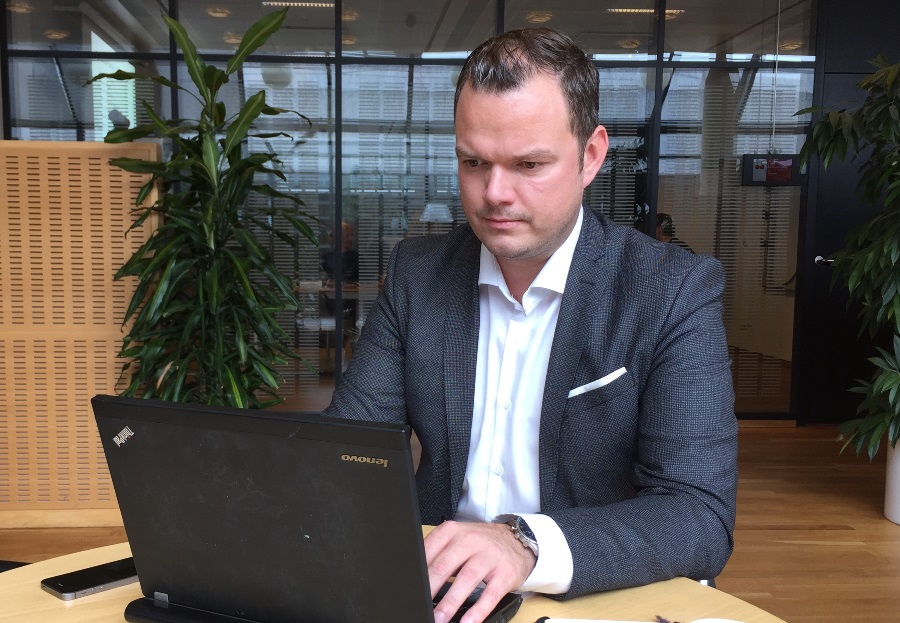Originally designed to distribute the virtual currency Bitcoin, blockchain technology seems to be the new black, offering as it does a variety of benefits such as a permanent audit trail, potential cost reduction and immutability. Only time will tell whether it will pay off to switch to a nascent, largely unregulated technology for the finance industry which has over 50 years of legacy systems built around the current regulatory environment.
"Blockchain is still a hyped technology. We're dipping our toes and have had a number of sessions across the Nordics with banks and merchants eager to hear about our first proof of concept," explains Simon Buchwaldt-Nissen, Digital Practices, Nets, who uses the first proof of concept to start a dialogue with the customer: "What are their needs and considerations, how mature are they in terms of considering a blockchain-based solution tailored to their needs, and is it the right technology for them or should they stick to their legacy technology for now."
His experience is that blockchain technology presents new opportunities and brings together the established world of banking with creative newcomers who, unrestrained by switching costs, have a higher risk tolerance.
A game of dominoes
Buying and Selling a House is the first proof of concept to come out of Nets' Digital Lab and its strategic partnership with Coinify. The blockchain-based prototype demonstrates the ability to record all documents associated with buying and selling a house, such as the home condition report, the energy performance certificate and the sales agreement, or any related events such as water damage, insurance claims, construction of an extension or warranty.
Like a game of dominoes, the logged documents are interdependent so that if the sale, for instance, depends on obtaining an energy performance certificate of a certain rating, it will be brought into effect once the required rating or other conditions are logged and the seller has accepted the bid. This automatically releases the escrow deposit, thus demonstrating the self-executing attributes of Smart Contracts.
When presenting the concept to Nordic banks and merchants, Simon Buchwaldt-Nissen likes to invite his hosts to take part in a fictitious sales process, playing the roles of the seller and the buyer of the house, the real estate agent and the bank. This way, the domino effect of the Smart Contract and the capabilities of blockchain become evident to the participants.
The documents related to the purchase of a house remain visible to those with access in a so-called 'permissioned' blockchain, and no one will be able to tamper with them once logged:
"Imagine a patchwork in which each square of fabric would represent a block on the chain. Once the patchwork is full, it will be reproduced ("hashed") in the first square of the next patchwork – or embedded in the next block on the chain," explains Simon Buchwaldt-Nissen.

“There’s a lot of hype about blockchain right now. The banks appreciate a tangible example of some of the possibilities and advantages of blockchain, allowing us to discuss it in the light of the needs of their business and end-users,” says Simon Buchwaldt-Nissen, Digital Practices, Nets.
Cloud-based blockchain technology enables multi-party access and highly efficient automated processes within Nets' first blockchain prototype, and third-party providers may easily tap into the process to offer value-added services such as repair, remodelling and design.
Early days yet
Blockchain technology paves the way for a myriad of possibilities, and Buying and Selling a House is just one example of the technology put to use. According to Jan Plenge, SVP Digital Innovation at Nets and Head of Digital Lab, the technology holds potential for payment products and services across the value chain, and the development work carried out at Nets' Digital Lab is thus relevant to customers of Nets' three business segments: Corporate Services, Financial & Network Services and Merchant Services.
"Right now, we're exploring the technology, innovating on our own pipeline and co-creating in close dialogue with our customers. We're not here to make large-scale, off-the-shelf blockchain-based solutions, quite the contrary," he says.
Nets will innovate on its own products and services to ensure the company remains a preferred strategic partner to its customers, and to pave the way for future commercial collaboration on blockchain.
Source: Barclay: ‘European Fintech & Payments’, Equity Research, 9 March 2016

